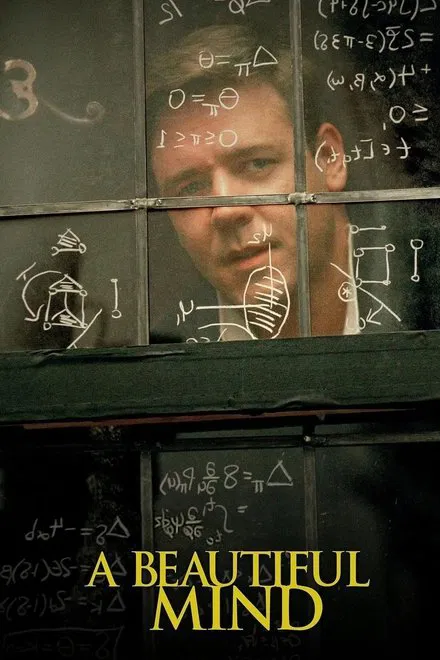
Directed by: Ron Howard
Starring: Russell Crowe, Jennifer Connelly, Ed Harris, Paul Bettany, Christopher Plummer
🧠 Introduction: Genius Entwined with Struggle
A Beautiful Mind (2001) is more than a standard biopic. It is a meditation on the intersection of brilliance and vulnerability, a true story that resonates because of its unflinching look at both the heights of genius and the depths of mental illness. The film chronicles the life of John Nash, a mathematical prodigy whose groundbreaking theories and struggle with schizophrenia shaped both his personal life and the world of academia. Directed by Ron Howard and anchored by Russell Crowe’s subtle, immersive performance, the film asks viewers to consider what it means to live with a mind both extraordinary and fragile.
🔢 The Early Spark: Princeton and the Pursuit of Originality
We first meet John Nash in the hallowed halls of Princeton in the late 1940s, a socially awkward but fiercely ambitious graduate student. Nash’s relentless pursuit of an “original idea” drives him to the fringes of campus life and friendship, but also leads to his breakthrough work in game theory—a concept that revolutionizes economics and political science. Howard’s direction and Crowe’s performance make Nash’s intellectual isolation palpable, capturing the tension between creativity and loneliness.
The film elegantly visualizes Nash’s thought process, using shimmering equations and shifting perspectives to illustrate the inner workings of a mind always searching for patterns and meaning. Yet, as Nash’s professional star rises, the seeds of his psychological unraveling are already being sown.
🌫️ Descent into Delusion: Schizophrenia’s Shadow
It is only after Nash’s marriage to the devoted Alicia (Jennifer Connelly) that the full extent of his mental illness becomes apparent. The film’s most daring narrative trick—presenting Nash’s hallucinations (Paul Bettany’s charismatic Charles, the mysterious William Parcher, and the imagined little girl Marcee) as real to both Nash and the audience—immerses viewers in the confusion and terror of schizophrenia. When the revelation comes, it is not only devastating for Nash, but for those who love him.
A Beautiful Mind never trivializes or romanticizes mental illness. Instead, it shows the relentless toll it takes: on Nash’s career, his marriage, and his self-image. Treatments are shown as both necessary and cruel, with Nash oscillating between lucidity and paranoia. The burden is shared by Alicia, whose loyalty is both heroic and heartbreakingly human.
🌹 Love, Recovery, and Resilience
The film’s second half is less about mathematics and more about the daily courage required to survive. Nash, refusing medication to preserve his intellectual faculties, learns to “ignore” his hallucinations through willpower and routine. The support of Alicia and the eventual understanding of colleagues allow Nash to return to academic life, albeit with constant struggle.
In a moving portrait of resilience, Nash is eventually awarded the Nobel Prize. His acceptance speech, simple and honest, credits his wife’s faith and the power of love in the face of overwhelming odds. The film doesn’t offer easy redemption—Nash’s illness is never “cured”—but it does provide hope that meaning and dignity can be found amid lifelong challenge.
🎯 Final Thoughts: The Complexity of the Mind
A Beautiful Mind endures not just as a tale of triumph, but as a meditation on complexity—the complexity of genius, of relationships, and of the human mind. It asks us to see past stigma and myth, to embrace the full spectrum of experience. Ultimately, Nash’s story is universal: a reminder that everyone carries burdens unseen, and that empathy, patience, and love are the truest forms of understanding.